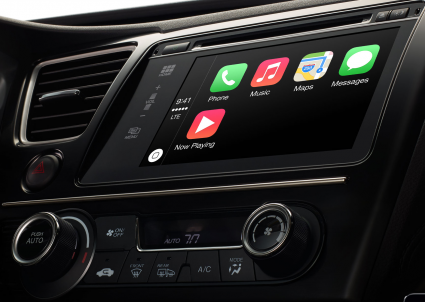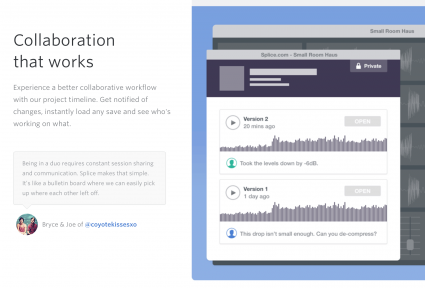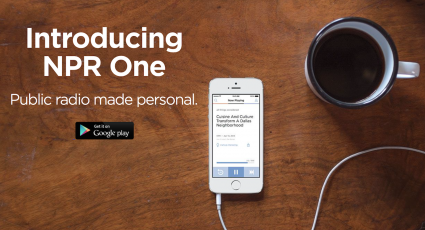In our "Why web audio can’t grow up" article, we presented the case for moving away from “podcasts” as the de-facto definition of web audio, to create new audio platforms and new ways to experience interacting with audio on the web. Quick summary: Podcasts are difficult to share, tough to discover and not inherently suited to community building. They just feel old!
Luckily we’re not the only ones who’ve noticed the problem, innovators of all stripes are getting fed up with the podcasting status quo. Here are some of the most amazing ideas and products these great minds are working on as they attempt to redefine what it means to find, make and consume web audio.
1. New networks for podcasts

Meanwhile, in the for profit sector, Alex Blumberg of This American Life and Planet Money is already rethinking old podcast advertising clichés in his new startup, Gimlet Media. Blumberg may have had a bit of an embarrassing start learning to pitch, but he’s now got some funding and some momentum. It wouldn’t be surprising to see Blumberg soon begin work on his own podcast distribution system, as initial reports on the startup suggested - especially now that Marco Arment, creator of Tumblr, Instapaper and Overcast is on board with funding
Risks: Aside from the challenges brilliantly outlined by billionaire Chris Sacca in the first episode of Blumberg’s Startup podcast, there’s some push back on the entire concept of podcast networks from smart people in the industry. Arment might be on board with Gimlet Media now, but just a few months ago he explained why he thinks the time for audio networks has already passed in his blog piece, “Podcast Networks are the Wrong Model.”
Rewards: Sustainable, high-quality long form audio on demand now and forevermore – and maybe even better ways to find it.
They said: “I was thinking exactly what you think I was thinking … I’m totally fucking this up. And also, I’m nowhere near ready to be doing this yet,” - Blumberg to John Biggs of Techcrunch on Blumberg’s early pitch to Chris Sacca.
2. Social networks for audio content

One of the most interesting features in this realm belongs to Overheard, which embraces audio recording’s unique ability to go on in the background of the user’s everyday life. With Overheard users can open the app and rewind back to hear the sounds that just happened, so there’s no need for users to constantly hold down the record button in hopes of grabbing awesome sound.
Risks: Similar products based around sharing pictures and sound together have largely been busts. There’s no guarantee the public will ever be interested in sharing short audio clips when the big screens on our computers and smart phones make it easy to check out images and .gifs without bothering the people around us.
Rewards: A world filled with successful, “OverHeard” type products is a journalistic gold mine. Imagine if we had loads of audio from the Ferguson protests to document what was happening when people didn’t know they were being recorded. Free access to sounds all over the world could even make written stories much richer thanks to tools such as our own Soundcite JS.
They said: “OverHeard is perhaps trying a little too hard to be like Vine, insofar as it’s attempting to create a social network around short-form recorded content. I’m just not sure there will be the same demand for (up to) 3-minute audio clips as there is for genius 6-second looping videos,” – Paul Sawers for The Next Web.
3. Mobile OS in cars

Risks: Michael O’Shea, president and CEO of Abalta Technologies, laid-out his critiques of the OS in the car model shortly after Carplay’s announcement. Among the biggest hold-ups to getting a mobile OS into every car: complications in dashboard architecture, safety concerns for third party apps and the potential for competition between Apple and Google hamstringing both companies. Not to even mention the expense – the first car to offer Carplay rings in at a cool $300 grand.
Rewards: If the tech giants succeed in taking over the vehicle in could mean big innovations in how we interact with audio, and plenty of room for podcasting companies to get a jump on dominating the space by offering the best car-ready experiences. If tools like the aforementioned social audio apps end up working out, and they’re integrated into the car, journalists could potentially have access to a live stream of amateur audio collected from big news events during their drive to work.
They said: “As handy as Siri’s natural speech recognition is when you’re just walking around with your phone, it really comes into its own in the car. Siri makes it easy to choose music, get directions, and read or send text messages—all by using your voice with natural speech, rather than menu-driven, formulaic commands,” – Jim Travers for Consumer Reports after taking Apple Carplay for a spin.
4. Integrating audio into maps
We all know and love Google Street View, but if the idea is to get us to feel what’s it’s really like to be on street it’s still missing two ingredients: motion and sound. Products like Soundcloud app Tracks on a Map and Amplifion’s super cool Sounds of Street View hope to correct that with their takes on how we can hear not just what’s next to us, but across the world. Either tool allows people to add sounds they picked-up at ambient locations, and listen in on what was happening in a given place at a given time.
Risks: As short-term projects these are already very inspiring, but without easy to use interfaces or built-in virality these seem destined to remain just what they are now, novelties.
Rewards: It’s not hard to imagine a product combining Google Maps with access to the sound of every nearby phone. The result would be a product that allowed journalists to listen in wherever they think there might be news, all from the comfort of their own couches.
They said: “If you move to one spot, you'll hear pigeons cooing, while another spot gives you the sound of people clinking glasses as they dine. The noises are all short, looping clips, so if you stand in one spot too long, the illusion of reality is broken,” – Carl Franzen for the Verge on Sounds of Street View.
5. Producing audio collaboratively

Risks: Though early Splice reviews are positive and musicians are basically collaborators by trade, startups are always a risky enterprise. A quick Google search for “collaborative music apps” quickly calls up a digital graveyard of collaborative music platforms that couldn’t quite nail it and competitors that haven’t achieved mass popularity.
Rewards: Despite the music focus of the current crop of collaborative audio apps, this breed of technology could have big impacts for newbies striving to emulate soundscape-driven podcasts like Radiolab. With community so heavily built into audio production, amateurs can get better by working directly with masters and save loads of time going down the wrong path. Not everyone has the resources to work 45 minutes for a single, brilliant minute of audio.
Radiolab Behind the Scenes from Radiolab on Vimeo.
They said: “Splice also aims to help artists better understand the building blocks, or DNA, of a song. Splice lets musicians see and analyze each specific element of a track, be it a MIDI, a clip, a musical instrument, etc.” – Megan Rose Dickey for Business Insider on how Splice plans to educate its audience about audio’s intricacies.
6. The “Pandora-for-news” apps

Risks: The granddaddy of this idea in music, Pandora itself only recently became profitable after years in the public eye. Rivet News Radio’s creator says it’s an entirely different ballgame for the spoken word, but it’s still something to keep an eye on. Additionally any company looking for a quick, easy way to make recommendations as precise as Pandora’s music predictions might be disappointed – Pandora’s founder has called their methods for categorization “profoundly unscalable,” though initial reviews suggest NPR One and Rivet News Radio are doing a pretty good job.
Rewards: Here’s a case where the rewards are obvious. The perfect audio delivered at the perfect time – what’s not to love?
They said: “That’s right: Real, live people are suggesting stories for you. In the tech world, this kind of craziness is pretty rare.” – Katherine Boehret’s review of NPR One for recode.net.
More podcasts and audio on the Web stories:
-
• From Carl Malamud to Dr. Dre to Ev Williams: The history of web audio
• The 4 Stages to Internet medium maturity: Why web audio can’t grow up
• Leaps and sounds: 6 product categories creating the future of web audio
• How to get rich in the podcasting gold rush: steal these 6 ideas from Odeo
• Alex Blumberg on StartUp podcast, Gimlet Media and the future of podcasting
• Jake Shapiro on PRX, developing Radiotopia and the future of web audio
About the author





